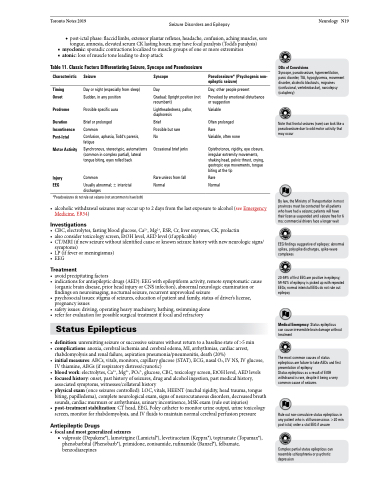Page 761 - TNFlipTest
P. 761
Toronto Notes 2019 Seizure Disorders and Epilepsy
◆ post-ictal phase: flaccid limbs, extensor plantar reflexes, headache, confusion, aching muscles, sore tongue, amnesia, elevated serum CK lasting hours; may have focal paralysis (Todd’s paralysis)
■ myoclonic:sporadiccontractionslocalizedtomusclegroupsofoneormoreextremities ■ atonic:lossofmuscletoneleadingtodropattack
Neurology N19
Table 11. Classic Factors Differentiating Seizure, Syncope and Pseudoseizure
DDx of Convulsions
Syncope, pseudoseizure, hyperventilation, panic disorder, TIA, hypoglycemia, movement disorder, alcoholic blackouts, migraines (confusional, vertebrobasilar), narcolepsy (cataplexy)
Note that frontal seizures (rare) can look like a pseudoseizure due to odd motor activity that may occur
By law, the Ministry of Transportation in most provinces must be contacted for all patients who have had a seizure; patients will have their license suspended until seizure free for 6 mo; commercial drivers face a longer wait
EEG findings suggestive of epilepsy: abnormal spikes, polyspike discharges, spike-wave complexes
20-59% of first EEG are positive in epilepsy; 59-92% of epilepsy is picked up with repeated EEGs; normal interictal EEGs do not rule out epilepsy
Medical Emergency: Status epilepticus can cause irreversible brain damage without treatment
The most common causes of status epilepticus are failure to take AEDs and first presentation of epilepsy
Status epilepticus as a result of EtOH withdrawal is rare, despite it being a very common cause of seizures
Rule out non-convulsive status epilepticus in any patient who is still unconscious >20 min post-ictal; order a stat EEG if unsure
Complex partial status epilepticus can resemble schizophrenia or psychotic depression
Characteristic
Timing Onset
Prodrome
Duration Incontinence Post-Ictal
Motor Activity
Injury EEG
Seizure
Day or night (especially from sleep) Sudden, in any position
Possible specific aura
Brief or prolonged Common
Confusion, aphasia, Todd's paresis, fatigue
Synchronous, stereotypic, automatisms (common in complex partial), lateral tongue biting, eyes rolled back
Common
Usually abnormal; ± interictal discharges
Syncope
Day
Gradual; Upright position (not recumbent)
Lightheadedness, pallor, diaphoresis
Brief
Possible but rare No
Occasional brief jerks
Rare unless from fall Normal
Pseudoseizure* (Psychogenic non- epileptic seizure)
Day; other people present
Provoked by emotional disturbance or suggestion
Variable
Often prolonged Rare
Variable, often none
Opisthotonos, rigidity, eye closure, irregular extremity movements, shaking head, pelvic thrust, crying, geotropic eye movements, tongue biting at the tip
Rare Normal
*Pseudoseizures do not rule out seizures (not uncommon to have both)
• alcoholicwithdrawalseizuresmayoccurupto2daysfromthelastexposuretoalcohol(seeEmergency Medicine, ER54)
Investigations
• CBC,electrolytes,fastingbloodglucose,Ca2+,Mg2+,ESR,Cr,liverenzymes,CK,prolactin
• alsoconsidertoxicologyscreen,EtOHlevel,AEDlevel(ifapplicable)
• CT/MRI(ifnewseizurewithoutidentifiedcauseorknownseizurehistorywithnewneurologicsigns/
symptoms)
• LP(iffeverormeningismus) • EEG
Treatment
• avoidprecipitatingfactors
• indicationsforantiepilepticdrugs(AED):EEGwithepileptiformactivity,remotesymptomaticcause
(organic brain disease, prior head injury or CNS infection), abnormal neurologic examination or
findings on neuroimaging, nocturnal seizure, recurrent unprovoked seizure
• psychosocialissues:stigmaofseizures,educationofpatientandfamily,statusofdriver’slicense,
pregnancy issues
• safetyissues:driving,operatingheavymachinery,bathing,swimmingalone
• referforevaluationforpossiblesurgicaltreatmentiffocalandrefractory
Status Epilepticus
• definition:unremittingseizureorsuccessiveseizureswithoutreturntoabaselinestateof>5min
• complications:anoxia,cerebralischemiaandcerebraledema,MI,arrhythmias,cardiacarrest,
rhabdomyolysis and renal failure, aspiration pneumonia/pneumonitis, death (20%)
• initialmeasures:ABCs,vitals,monitors,capillaryglucose(STAT),ECG,nasalO2,IVNS,IVglucose,
IV thiamine, ABGs (if respiratory distress/cyanotic)
• blood work: electrolytes, Ca2+, Mg2+, PO43-, glucose, CBC, toxicology screen, EtOH level, AED levels
• focusedhistory:onset,pasthistoryofseizures,drugandalcoholingestion,pastmedicalhistory,
associated symptoms, witnesses/collateral history
• physicalexam(onceseizurescontrolled):LOC,vitals,HEENT(nuchalrigidity,headtrauma,tongue
biting, papilledema), complete neurological exam, signs of neurocutaneous disorders, decreased breath
sounds, cardiac murmurs or arrhythmias, urinary incontinence, MSK exam (rule out injuries)
• post-treatmentstabilization:CThead,EEG,Foleycathetertomonitorurineoutput,urinetoxicology
screen, monitor for rhabdomyolysis, and IV fluids to maintain normal cerebral perfusion pressure
Antiepileptic Drugs
• focalandmostgeneralizedseizures
■ valproate (Depakene®), lamotrigine (Lamictal®), levetiracetam (Keppra®), topiramate (Topamax®),
phenobarbital (Phenobarb®), primidone, zonisamide, rufinamide (Banzel®), felbamate, benzodiazepines


